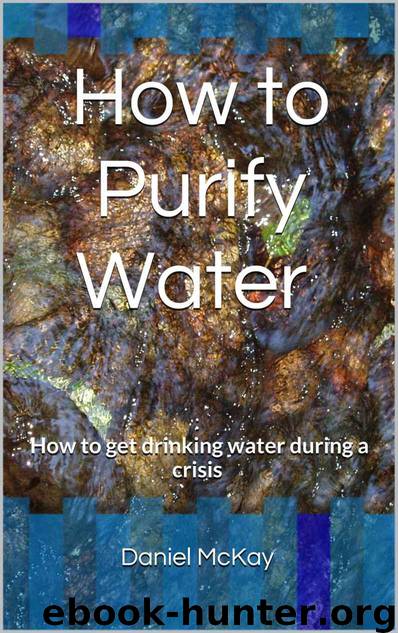How to Purify Water : : How to Get Drinking Water During a Crisis by Daniel McKay

Author:Daniel McKay [McKay, Daniel]
Language: eng
Format: epub
Tags: Science & Math, Earth Sciences, Environmental Science, Sports & Outdoors, Hiking & Camping, Camping, One Hour (33-43 Pages), Professional & Technical, Professional Science, Environment, Outdoors & Nature
Amazon: B009YP2YX8
Published: 2012-10-29T04:00:00+00:00
Chemical Treatment
The use of chemicals in water treatment and purification functions by killing off the germs and bacteria in the water. The principle is that there is a happy medium in the dilution of water with chemicals whereby the chemicals will kill all of the bugs, but the strength of the chemicals is not enough to harm us human beings.
Note however, there are a couple of downsides to using chemical treatment alone. Firstly, you need to make sure you get the chemical balance correct, too many chemicals are harmful to us, too few and you will not kill the nasty’s, which are in the water.
Secondly, the chemicals remain in the water after they have killed the nasty’s, which also happen to remain in the water and can cause the water to be cloudy and a little unappealing. This can be taken care of with a post chemical treatment filtration, which will remove the muck from the water.
Also, the chemicals can leave a strange taste or tang in the water. So before using the water you can always add some vitamin C, which will not only improve the quality of the water, but if you add the flavored tablets this will also serve to combat the taste.
Finally, there is the risk (albeit low) that you are allergic one or more of the chemicals used in this process. Therefore, you should confirm that you do not have allergy to the chemicals being used, particularly to iodine.
After implementing any of the following methods it is recommendable to test the water quality prior to consumption. This can be done using a water safety kit as described in a previous chapter in this ebook.
In all of the following methods it is recommendable to pre-filter the water prior to the purification. This can be done with coffee filters or a cloth. The point is to take out any of the solids in the water.
The most common methods of chemical water purification are those using iodine and chlorine. These two methods are described below. An advantage of the following methods, especially the household bleach method is that you can purify relatively large volumes of water at a time using very little energy (unlike boiling water for example).
Method 1
This is a popular and easy technique using iodine, which is used by campers and wilderness folk alike. If you happen to use this out in the wilderness, try and get water from a stream or river as opposed to that from a pond or lake. Also, try to get clear clean looking water, which has little or no suspended solids. This will help with the end result.
Equipment Needed
Iodine Tincture Solution (should be 2% iodine, 47 % alcohol. Generally available from drugstores for a few bucks.) Note, get the bottle with the eyedropper if there is any option, as you will need this.
A Water bottle.
Water source.
Vitamin C tablets.
Cloth or coffee filter (may not be needed, but worth having available).
Download
This site does not store any files on its server. We only index and link to content provided by other sites. Please contact the content providers to delete copyright contents if any and email us, we'll remove relevant links or contents immediately.
| Camping | Excursion Guides |
| Instructional | Walking |
In a Sunburned Country by Bill Bryson(3501)
Annapurna by Maurice Herzog(3444)
How to Read Nature by Tristan Gooley(3289)
Dangerous Girls by Haas Abigail(2994)
SAS Survival Handbook by John 'Lofty' Wiseman(2694)
The Lost Art of Reading Nature's Signs by Tristan Gooley(2655)
In the Woods by Tana French(2558)
The Stranger in the Woods by Michael Finkel(2482)
Food and Water in an Emergency by Food & Water In An Emergency(2369)
Guns, Germs and Steel by Diamond Jared(2332)
Everest the Cruel Way by Joe Tasker(2305)
Wild: From Lost to Found on the Pacific Crest Trail by Cheryl Strayed(2227)
Sea Survival Handbook by Keith Colwell(2212)
Backpacker the Complete Guide to Backpacking by Backpacker Magazine(2210)
Trail Magic by Trevelyan Quest Edwards & Hazel Edwards(2142)
Ultimate Navigation Manual by Lyle Brotherton(2136)
Welcome to the Goddamn Ice Cube by Blair Braverman(2011)
Birds of the Pacific Northwest by Shewey John; Blount Tim;(1942)
The Last Flight by Julie Clark(1924)
